Carrier 23 XL User Manual
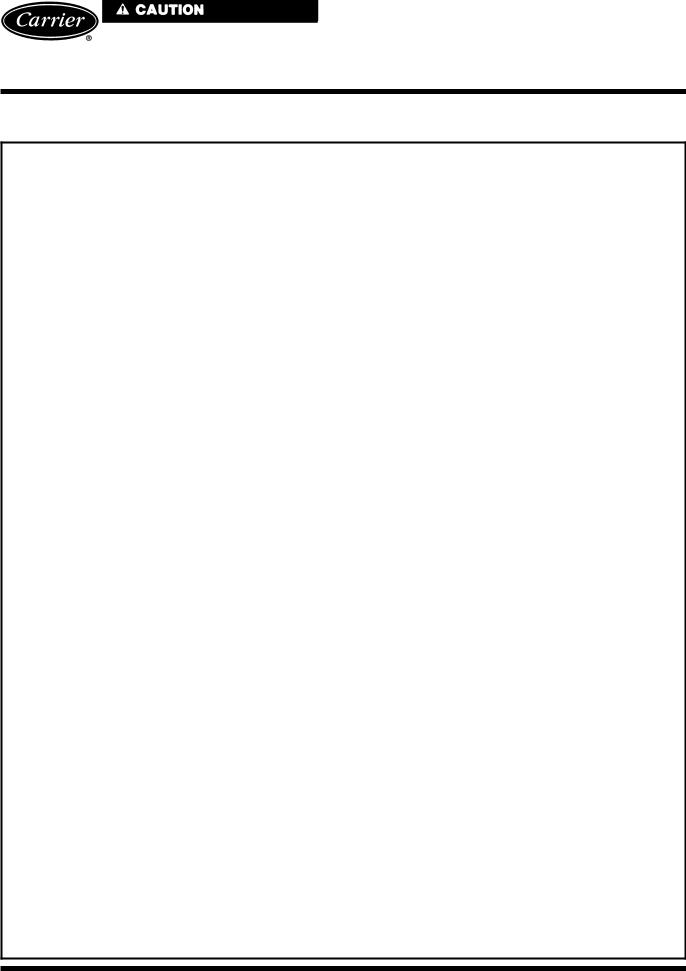
23XL 50/60 Hz Hermetic Screw Liquid Chillers
With HCFC-22 and HFC-134a
Installation Instructions
SAFETY CONSIDERATIONS
Screw liquid chillers are designed to provide safe and reliable service when operated within design speci®cations. When operating this equipment, use good judgment and follow safety precautions to avoid damage to equipment and property or injury to personnel.
Be sure you understand and follow the procedures and safety precautions contained in the machine instructions as well as those listed in this guide.
DO NOT VENT refrigerant relief devices within a building. Outlet from rupture disc or relief valve must be vented outdoors in accordance with the latest edition of ANSI/ASHRAE 15 (American National Standards Institute/American Society of Heating, Refrigeration, and Air Conditioning Engineers). The accumulation of refrigerant in an enclosed space can displace oxygen and cause asphyxiation.
PROVIDE adequate ventilation in accordance with ANSI/ASHRAE 15, especially for enclosed and low overhead spaces. Inhalation of high concentrations of vapor is harmful and may cause heart irregularities, unconsciousness, or death. Intentional misuse can be fatal. Vapor is heavier than air and reduces the amount of oxygen available for breathing. Product causes eye and skin irritation. Decomposition products are hazardous.
DO NOT USE OXYGEN to purge lines or to pressurize a machine for any purpose. Oxygen gas reacts violently with oil, grease, and other common substances.
DO NOT USE air to leak test. Use only refrigerant or dry nitrogen.
NEVER EXCEED speci®ed test pressures. VERIFY the allowable test pressure by checking the instruction literature and the design pressures on the equipment nameplate.
DO NOT VALVE OFF any safety device.
BE SURE that all pressure relief devices are properly installed and functioning before operating any machine.
DO NOT WELD OR FLAMECUT any refrigerant line or vessel until all refrigerant (liquid and vapor) has been removed from chiller. Traces of vapor should be displaced with dry air or nitrogen and the work area should be well ventilated. Refrigerant in contact with an open ¯ame produces toxic gases.
DO NOT USE eyebolts or eyebolt holes to rig machine sections or the entire assembly.
DO NOT work on high-voltage equipment unless you are a quali- ®ed electrician.
DO NOT WORK ON electrical components, including control center, switches, starters, or oil heater until you are sure ALL POWER IS OFF and no residual voltage can leak from capacitors or solidstate components.
LOCK OPEN AND TAG electrical circuits during servicing. IF WORK IS INTERRUPTED, con®rm that all circuits are deenergized before resuming work.
DO NOT syphon refrigerant.
AVOID SPILLING liquid refrigerant on skin or getting it into the eyes. USE SAFETY GOGGLES. Wash any spills from the skin with soap and water. If liquid refrigerant enters the eyes, IMMEDIATELY FLUSH EYES with water and consult a physician.
NEVER APPLY an open ¯ame or live steam to a refrigerant cylinder. Dangerous over pressure can result. When it is necessary to heat refrigerant, use only warm (110 F [43 C]) water.
DO NOT REUSE disposable (nonreturnable) cylinders or attempt to re®ll them. It is DANGEROUS AND ILLEGAL. When cylinder is emptied, evacuate remaining gas pressure, loosen the collar, and unscrew and discard the valve stem. DO NOT INCINERATE.
CHECK THE REFRIGERANT TYPE before adding refrigerant to the machine. The introduction of the wrong refrigerant can cause machine damage or malfunction.
Operation of this equipment with refrigerants other than those cited herein should comply with ANSI/ASHRAE-15 (latest edition). Contact Carrier for further information on use of this machine with other refrigerants.
DO NOT ATTEMPT TO REMOVE ®ttings, covers, etc., while machine is under pressure or while machine is running. Be sure pressure is at 0 psig (0 kPa) before breaking any refrigerant connection.
CAREFULLY INSPECT all relief valves, rupture discs, and other relief devices AT LEAST ONCE A YEAR. If machine operates in a corrosive atmosphere, inspect the devices at more frequent intervals.
DO NOT ATTEMPT TO REPAIR OR RECONDITION any relief valve when corrosion or build-up of foreign material (rust, dirt, scale, etc.) is found within the valve body or mechanism. Replace the valve.
DO NOT install relief devices in series or backwards.
USE CARE when working near or in line with a compressed spring. Sudden release of the spring can cause it and objects in its path to act as projectiles.
DO NOT STEP on refrigerant lines. Broken lines can whip about and release refrigerant, causing personal injury.
DO NOT climb over a machine. Use platform, catwalk, or staging. Follow safe practices when using ladders.
USE MECHANICAL EQUIPMENT (crane, hoist, etc.) to lift or move inspection covers or other heavy components. Even if components are light, use mechanical equipment when there is a risk of slipping or losing your balance.
BE AWARE that certain automatic start arrangements CAN ENGAGE THE STARTER, TOWER FAN, OR PUMPS. Open the disconnect ahead of the starter, tower fan and pumps. Shut off the machine or pump before servicing equipment.
USE only repaired or replacement parts that meet the code requirements of the original equipment.
DO NOT VENT OR DRAIN waterboxes containing industrial brines, liquid, gases, or semisolids without the permission of your process control group.
DO NOT LOOSEN waterbox cover bolts until the waterbox has been completely drained.
DOUBLE-CHECK that coupling nut wrenches, dial indicators, or other items have been removed before rotating any shafts.
DO NOT LOOSEN a packing gland nut before checking that the nut has a positive thread engagement.
PERIODICALLY INSPECT all valves, ®ttings, and piping for corrosion, rust, leaks, or damage.
PROVIDE A DRAIN connection in the vent line near each pressure relief device to prevent a build-up of condensate or rain water.
Manufacturer reserves the right to discontinue, or change at any time, speci®cations or designs without notice and without incurring obligations.
Book |
2 |
|
PC 211 |
Catalog No. 532-303 |
Printed in U.S.A. |
Form 23XL-2SI |
Pg 1 |
9-94 |
Replaces: 23XL-1SI |
Tab |
5e |
|
|
|
|
|
|
|
|
|
|
|
|
|
|
|
|
|
|
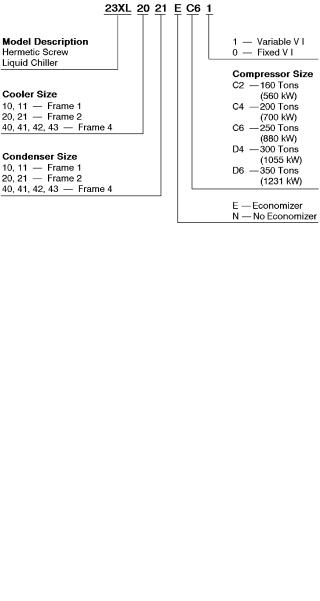
CONTENTS
Page
SAFETY CONSIDERATIONS . . . . . . . . . . . . . . . . . . . 1
INTRODUCTION . . . . . . . . . . . . . . . . . . . . . . . . . . . . . . 2
General . . . . . . . . . . . . . . . . . . . . . . . . . . . . . . . . . . . . . . 2
Job Data . . . . . . . . . . . . . . . . . . . . . . . . . . . . . . . . . . . . 2
Equipment Required . . . . . . . . . . . . . . . . . . . . . . . . . 2
INSTALLATION . . . . . . . . . . . . . . . . . . . . . . . . . . . . . 2-34
Receiving the Machine . . . . . . . . . . . . . . . . . . . . . . . 2
·INSPECT SHIPMENT
·IDENTIFY MACHINE
·PROVIDE MACHINE PROTECTION
Rigging the Machine . . . . . . . . . . . . . . . . . . . . . . . . . 4
·RIG MACHINE ASSEMBLY
·RIG MACHINE COMPONENTS
Install Machine Supports . . . . . . . . . . . . . . . . . . . . 16
·INSTALL STANDARD ISOLATION
·INSTALL OPTIONAL OR ACCESSORY ISOLATION
·INSTALL SPRING ISOLATION
Connect Piping . . . . . . . . . . . . . . . . . . . . . . . . . . . . . 18
·INSTALL WATER PIPING TO HEAT EXCHANGERS
·INSTALL VENT PIPING TO RELIEF DEVICES
Make Electrical Connections . . . . . . . . . . . . . . . . . 25
·CONNECT CONTROL INPUTS
·CONNECT CONTROL OUTPUTS
·CONNECT STARTER
·INSULATE MOTOR TERMINALS AND LEAD WIRE ENDS
·CONNECT POWER WIRE TO OIL HEATER CONTACTOR (Frame 1 and 2)
·CONNECT COMMUNICATION AND CONTROL WIRING FROM STARTER TO POWER PANEL
·CARRIER COMFORT NETWORK INTERFACE
Install Field Insulation . . . . . . . . . . . . . . . . . . . . . . . 30 · FACTORY-INSTALLED INSULATION
INSTALLATION START-UP REQUEST
CHECKLIST . . . . . . . . . . . . . . . . . . . . . . . . . . CL-1, CL-2
INTRODUCTION
General Ð The 23XL machine is factory assembled, wired, and leak tested. Installation (not by Carrier) consists primarily of establishing water and electrical services to the machine. Rigging, installation, ®eld wiring, and ®eld piping are the responsibility of the contractor and/or customer. Carrier has no installation responsibilities for the equipment.
Job Data
Necessary information consists of:
·job contract or speci®cations
·machine location prints
·rigging information
·piping prints and details
·®eld wiring drawings
·starter manufacturer's installation details
·Carrier certi®ed prints
Equipment Required
·mechanic's tools (refrigeration)
·volt-ohmmeter and clamp-on ammeter
·leak detector (halide or electronic)
·absolute pressure manometer or wet-bulb vacuum indicator
·portable vacuum pumps
INSTALLATION
Receiving the Machine
INSPECT SHIPMENT
Do not open any valves or break any connections. The standard 23XL machine is shipped with a full refrigerant charge. Some machines may be shipped with a nitrogen holding charge as an option.
1.Inspect for shipping damage while the machine is still on shipping conveyance. If the machine appears to be damaged or has been torn loose from its anchorage, have it examined by transportation inspectors before removal. Forward claim papers directly to the transportation company. The manufacturer is not responsible for any damage incurred in transit.
2.Check all items against shipping list. Immediately notify the nearest Carrier representative if any item is missing.
3.To prevent loss or damage, leave all parts in original packages until installation. All openings are closed with covers or plugs to prevent dirt and debris from entering during shipping. The 23XL is shipped with a full operating oil charge.
IDENTIFY MACHINE Ð The machine model number, serial number, and heat exchanger sizes are stamped on machine information plate (Fig. 1, 2, and 3). Check this information against shipping papers and job data.
LEGEND
VI Ð Volumetric Index
Fig. 1 Ð Model Number Identi®cation
PROVIDE MACHINE PROTECTION Ð Protect machine and starter from construction dirt and moisture. Keep protective shipping covers in place until machine is ready for installation.
If machine is exposed to freezing temperatures after water circuits have been installed, open waterbox drains and remove all water from cooler and condenser. Leave drains open until system is ®lled.
2
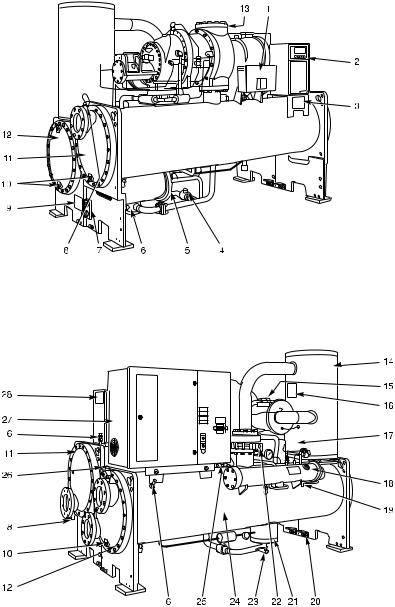
FRONT VIEW
1 Ð Power Panel
2 Ð Local Interface Display (LID) Control Center
3 Ð ASME Nameplate, Cooler
4 Ð Cooler Refrigerant Isolation Valve
5 Ð ASME Nameplate, Economizer (Hidden)
6 Ð Service Valve
7 Ð Take-Apart Rabbet Fit Connector (Lower)
8 Ð Cooler Temperature Sensor
9 Ð ASME Nameplate, Condenser
10 Ð Typical Waterbox Drain Port
11 Ð Cooler Supply/Return End
Waterbox Cover
12 Ð Condenser Supply/Return End
Waterbox Cover
13 Ð Compressor Nameplate (Hidden)
REAR VIEW
14 Ð Oil Separator
15 Ð ASME Nameplate, Muffler (Hidden)
16 Ð ASME Nameplate, Oil Separator
17 Ð Cooler Relief Valves (Hidden)
18 Ð Oil Sump Filter Assembly
19 Ð Oil Charging Valve
20 Ð Vessel Separation Feet
21 Ð Float Chamber
22 Ð Condenser Isolation Valve (Option or Accessory)
23 Ð Refrigerant Charging Valve
24 Ð Condenser
25 Ð Condenser Relief Valves (Hidden)
26 Ð Take-Apart Rabbet Fit Connector (Upper)
27 Ð Unit Mounted Starter (Option)
28 Ð Machine Identi®cation Nameplate
Fig. 2 Ð Typical 23XL Installation (Frame 1 and 2 Machines)
3
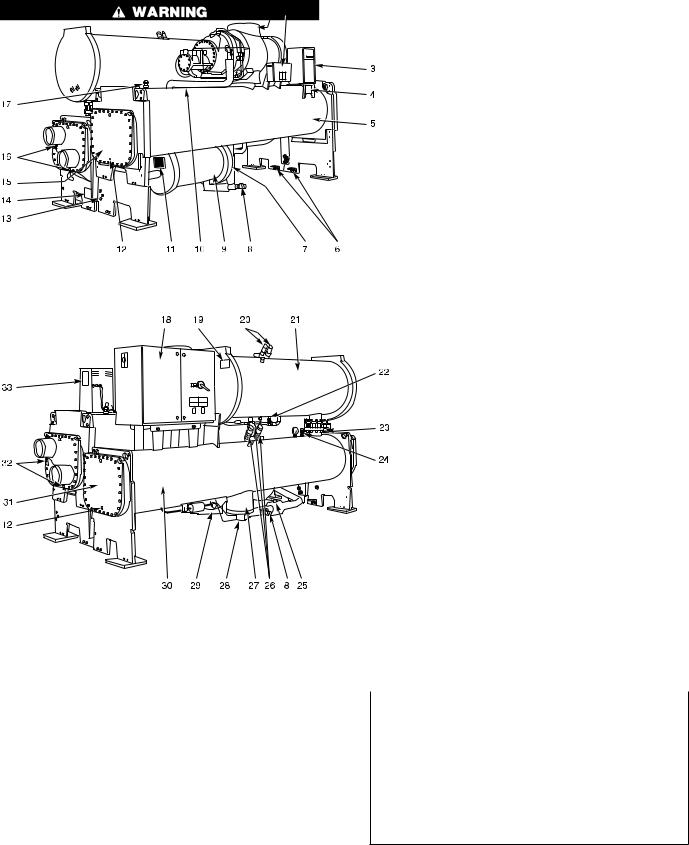
FRONT VIEW
1 Ð Compressor Nameplate (Hidden)
2 Ð Power Panel
3 Ð Local Interface Display (LID) Control Center
4 Ð ASME Nameplate, Cooler
5 Ð Cooler
6 Ð Vessel Separation Feet
7 Ð Economizer Float Valve Access Cover
(Hidden)
8 Ð Refrigerant Charging Valve
9 Ð Economizer
10 Ð Oil Filter Assembly (Hidden)
11 Ð ASME Nameplate, Economizer
12 Ð Typical Waterbox Drain Port
13 Ð Take-Apart Rabbet Fit Connector
14 Ð ASME Nameplate, Condenser
15 Ð Cooler Supply/Return End Waterbox Cover
16 Ð Condenser Temperature Sensors
17 Ð Cooler Relief Valve
REAR VIEW
18 Ð Unit Mounted Starter (Option)
19 Ð ASME Nameplate, Oil Separator
20 Ð Oil Separator Relief Valves
21 Ð Oil Separator
22 Ð Oil Charging Valve
23 Ð Condenser Isolation Valve (Option or Accessory)
24 Ð Service Valve
25 Ð Cooler Refrigerant Isolation Valve
26 Ð Condenser Relief Valves and Oil Filter
27 Ð Float Chamber
28 Ð Poppet Valve Assembly
29 Ð Motor Cooling Isolation Valve
30 Ð Condenser
31 Ð Condenser Supply/Return End Waterbox Cover
32 Ð Cooler Temperature Sensors
33 Ð Machine Identi®cation Nameplate
Fig. 3 Ð Typical 23XL Installation (Frame 4 Machine)
Rigging the Machine Ð The 23XL can be rigged as an entire assembly. It also has ¯anged connections that allow the compressor, cooler, condenser, and oil separator sections to be separated to ful®ll speci®c installation requirements.
RIG MACHINE ASSEMBLY Ð See rigging instructions in plastic envelope attached to machine. Also refer to rigging guide (Fig. 4 and 5), physical data in Fig. 6 and 7, and Tables 1-6. Lift machine only from the 3 points indicated in the rigging guide. Spreader bar must be used. Each lifting cable or chain must be capable of supporting the entire weight of the machine.
Lifting machine from points other than those speci®ed may result in serious damage and personal injury. Rigging equipment and procedure must be adequate for machine weight. See Tables 1-6 for machine weights.
NOTE: These weights are broken down into component sections for use when installing the unit in sections. For complete machine weight, add all section components together. Total machine weight (Table 6) is also stenciled on the cooler and condenser sections.
4
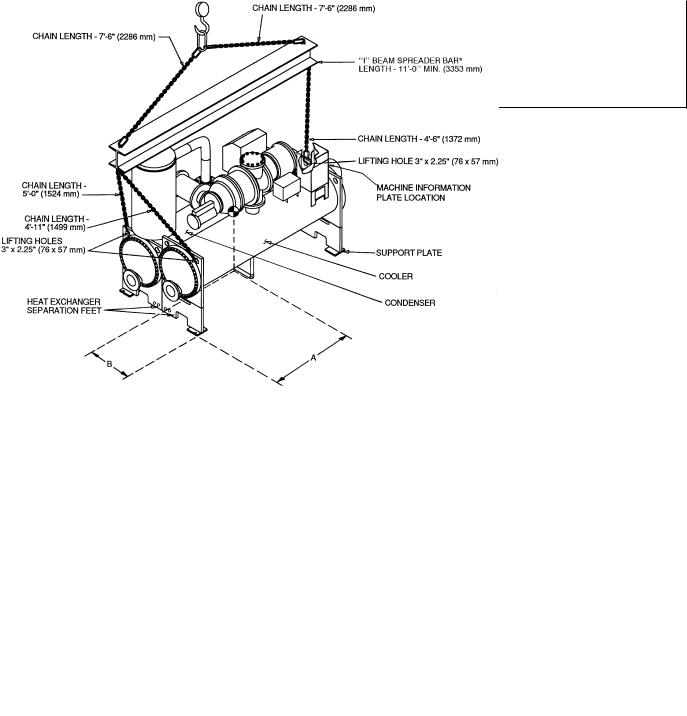
→
The compressor is heavy. To avoid bodily injury, lift the compressor only by using cables or slings. Do not lift the compressor using threaded eyebolts. Metric threaded eyebolts are provided only for lifting individual compressor castings.
IMPORTANT: Only a quali®ed service technician should disassemble and reassemble the machine. After reassembly, the machine must be dehydrated and leak tested.
RIG MACHINE COMPONENTS Ð Refer to instructions below, Fig. 8-12, and Carrier certi®ed prints for machine disassembly.
Do not attempt to cut refrigeration lines or disconnect ¯anges or ®ttings while machine is under pressure. Cutting lines or disconnecting ¯anges or ®ttings can result in personal injury or damage to the unit. Be sure both refrigerant and oil charge are removed from the machine before separating the components.
NOTE: If the cooler and condenser vessels must be separated, the heat exchanger separation feet must be unbolted, rotated, and rebolted in order to keep each heat exchanger level. See Fig. 4, 5, and 8-12.
NOTE: Sensor wiring must be disconnected. Label each wire before removal (see Carrier certi®ed prints). Remove all transducer and thermistor wires at the sensor. Clip all wire ties necessary to remove the wires from the heat exchangers. Remove the control wiring and oil heater wiring (Frame 1 and 2 machines) at the power panel and the main motor leads at the starter lugs before disconnecting the starter from the machine.
*Carrier recommends that ``I'' Beam Spreader Bars be ®eld supplied and installed.
NOTES:
1.Each chain must be capable of supporting the entire weight of the machine. Maximum weight of machine is 13,200 lbs (5940 Kg).
2.Chain lengths shown are typical for 15 ft (4572 mm) lifting height. Some minor
adjustment may be required. |
Suggested ``I'' Beam Spreader Bar* |
|
HEAT |
CENTER OF GRAVITY Ð |
MAXIMUM |
|||||
APPROXIMATE DIMENSIONS |
|||||||
EXCHANGER |
|
|
|
|
WEIGHT |
||
A (Length) |
B (Width) |
||||||
SIZE |
|
|
|||||
|
ft-in. |
mm |
ft-in. |
mm |
lb |
Kg |
|
10 or 11 |
3- 8 |
1117 |
1-11 |
572 |
11,810 |
5357 |
|
20 or 21 |
3-10 |
1161 |
2- 0 |
600 |
13,200 |
5940 |
|
OPTIONS |
ENGLISH |
SI |
|
in. x lb/ft |
cm x N/m |
||
|
|||
1 |
S12 x 31.8 |
S30 x 464 |
|
2 |
S10 x 35 |
S25.4 x 511 |
|
3 |
W12 x 22 |
W30 x 321 |
|
4 |
W10 x 25 |
W25.4 x 365 |
Fig. 4 Ð Machine Rigging Guide (Frame 1 and 2 Machines)
5 |
796 |
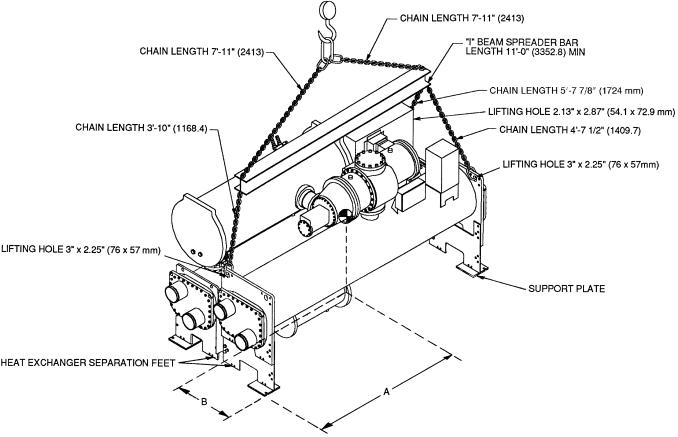
NOTES:
1.Each chain must be capable of supporting the entire weight of the machine. Maximum weight of machine is 22,300 lbs (10,116 Kg).
2.Chain lengths shown are typical for 15 ft (4572 mm) lifting height. Some minor adjustment may be required.
3.[ ] indicates millimeters.
|
CENTER OF GRAVITY Ð |
MAXIMUM WEIGHT* |
|||||||
|
APPROXIMATE DIMENSIONS |
||||||||
HEAT EXCHANGER |
|
|
|||||||
|
A |
|
B |
|
|
||||
SIZE |
|
|
|
|
|||||
(Length) |
(Width) |
lb |
kg |
||||||
|
|||||||||
|
ft-in. |
|
mm |
ft-in. |
|
mm |
|
|
|
40, 41, 42, or 43 |
6-4 |
|
1930 |
2-8 |
|
813 |
22,300 |
10,116 |
|
*Includes marine waterboxes and refrigerant charge.
Suggested ``I'' Beam Spreader Bar²
OPTIONS |
ENGLISH |
SI |
|
in. x lb/ft |
cm x N/m |
||
|
|||
1 |
S12 x 31.8 |
S30 x 464 |
|
2 |
S10 x 35 |
S25.4 x 511 |
|
3 |
W12 x 22 |
W30 x 321 |
|
4 |
W10 x 25 |
W25.4 x 365 |
²Carrier recommends that ``I'' beam spreader bars be ®eld supplied and installed.
Fig. 5 Ð Machine Rigging Guide
(Frame 4 Machines)
6
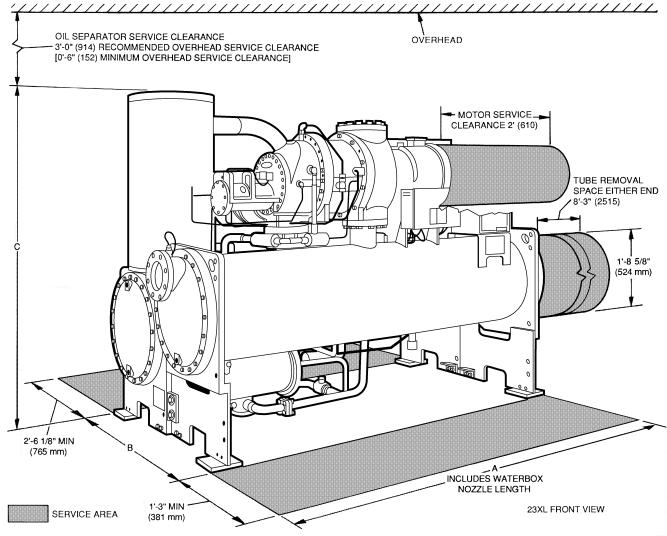
23-22
HEAT EXCHANGER |
|
A (LENGTH) |
|
OVERALL |
OVERALL |
NOZZLE PIPE SIZE |
|||||
1 Pass |
2 and 3 Pass* |
B (WIDTH) |
C (HEIGHT) |
|
(in.) |
||||||
SIZE |
|
||||||||||
|
ft-in. |
mm |
ft-in. |
mm |
ft-in. |
mm |
ft-in. |
mm |
1-Pass |
2 and 3-Pass |
|
10 or 11 |
9-5 |
2870 |
9-61¤2 |
2908 |
4- 91¤4 |
1454 |
6- 95¤8 |
2073 |
6 |
6 |
|
20 or 21 |
4-11 |
1499 |
6-113¤8 |
2118 |
8 |
6 |
|||||
|
|
|
|
||||||||
*2 and 3-pass length applies if either (or both) cooler or condenser is a 2 or 3-pass design.
NOTES:
1.Service access should be provided per ANSI/ASHRAE 15 (American National Standards Institute/American Society of Heating Refrigeration and Air Conditioning Engineers), Latest Edition. NFPA (National Fire Protection Association) 70 and local safety codes.
2.Allow at least 6 in. (152 mm) overhead clearance for service rigging.
3.Certi®ed drawings available upon request.
→ |
Fig. 6 Ð 23XL Dimensions (Frame 1 and 2 Machines) |
7 |
796 |
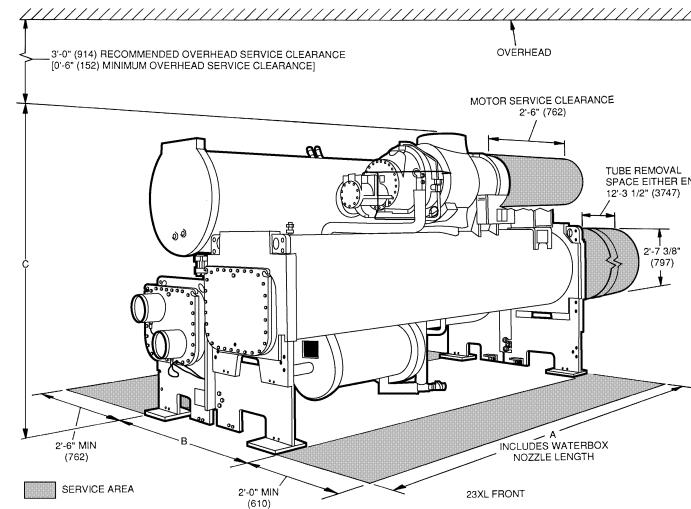
NOTES:
1.For ¯anged waterbox nozzles, refer to the certi®ed drawings for length addition measurements.
2.Service access should be provided based on American Society of Heating, Refrigeration, and Air Conditioning Engineers (ASHRAE) 15, latest edition, National Fire Protection Association (NFPA) 70, and local safety codes.
3.A minimum 6 in. (152 mm) overhead clearance for service rigging is recommended.
4.Certi®ed drawings are available upon request.
5.[ ] indicates millimeters.
HEAT EXCHANGER |
|
A (LENGTH) |
|
OVERALL |
OVERALL |
|
NOZZLE PIPE SIZE (in.) |
|||||||||||
(Cooler and |
2 Pass* |
|
1 or 3 Pass² |
B (WIDTH) |
C (HEIGHT) |
|
(Nominal Pipe Size) |
|||||||||||
Condenser Size) |
ft-in. |
mm |
|
ft-in. |
mm |
ft-in. |
mm |
ft-in. |
mm |
|
1-Pass |
2-Pass |
3-Pass |
|||||
|
|
|
|
|||||||||||||||
40-43 |
|
13-73¤4 |
4159 |
|
14-31¤4 |
4350 |
5-107¤8 |
1800 |
7-611¤16 |
2303 |
|
10 |
8 |
6 |
||||
|
|
|
|
|
|
|
|
|
|
|
|
|
|
|
|
|||
|
HEAT EXCHANGER |
|
|
|
A (Length With |
|
|
|
|
|||||||||
|
|
|
Marine Waterbox Ð Not Shown) |
|
|
|
|
|||||||||||
|
|
(Cooler and |
|
|
|
|
|
|
|
|
|
|
|
|
|
|
||
|
|
|
|
2 Pass* |
1 or 3 Pass² |
|
|
|
||||||||||
|
|
Condenser Size) |
|
|
|
|
|
|||||||||||
|
|
|
|
|
|
|
ft-in. |
|
mm |
ft.-in. |
|
mm |
|
|
|
|||
|
|
40-43 |
|
|
|
14-95¤8 |
|
4512 |
16-51¤2 |
|
|
5017 |
|
|
|
|||
*Assumes both cooler and condenser nozzles on same end of chiller.
²1 or 3 pass length applies if either (or both) cooler or condenser i s a 1 or 3 pass design.
Fig. 7 Ð 23XL Dimensions (Frame 4 Machines)
9
Table 1 Ð 23XL Compressor Weights
23XL |
COMPRESSOR SIZE |
ASSEMBLY |
||
(Less Motor) |
||||
UNIT |
(Tons) |
|||
lb |
kg |
|||
|
|
|||
Frame 1 |
C2 |
2270 |
1029 |
|
C4 |
2300 |
1043 |
||
|
||||
Frame 2 |
C6 |
2400 |
1088 |
|
Frame 4 |
D4 |
3300 |
1497 |
|
D6 |
3400 |
1542 |
||
|
||||
Table 2 Ð 23XL Component Weights
COMPONENT |
FRAME 1 AND 2 |
FRAME 4 |
|||
lb |
kg |
lb |
kg |
||
|
|||||
Oil Separator |
1180 |
535 |
2880* |
1306* |
|
Economizer² |
296 |
134 |
560 |
254 |
|
Muffler |
170 |
77 |
* |
* |
|
Discharge Piping: |
44 |
20 |
Ð |
Ð |
|
Pipe |
|||||
Isolation Valve² |
30 |
14 |
30 |
14 |
|
Adaptor Flange |
76 |
34 |
76 |
34 |
|
Power Panel |
20 |
9 |
20 |
9 |
|
Starter² |
500 |
227 |
500 |
227 |
|
Control Center |
31 |
14 |
31 |
14 |
|
*The Frame 4 muffler is included in the oil separator weight. ²Optional.
Table 3 Ð 23XL Motor Weights*
COMPRESSOR |
MAX IkW |
STATOR |
ROTOR |
|
MOTOR CASING AND COVER |
||||
Size |
VI Type |
lb |
kg |
lb |
|
kg |
lb |
kg |
|
|
|
||||||||
C2 |
0 |
125 |
230 |
104 |
58 |
|
26 |
310 |
141 |
C4 |
0 |
155 |
249 |
113 |
63 |
|
29 |
310 |
141 |
C4 |
1 |
195 |
276 |
125 |
69 |
|
31 |
310 |
141 |
C6 |
0 or 1 |
|
|||||||
|
|
|
|
|
|
|
|
||
D4 |
0 or 1 |
280 |
460 |
208 |
110 |
|
49 |
370 |
167 |
D6 |
0 or 1 |
280 |
460 |
208 |
110 |
|
49 |
370 |
167 |
LEGEND
VI Ð Volumetric Index
*C2-C6 listed weights are for low-voltage motors (200-600 v). D4-D6 listed weights are for low-voltage motors (320-600 v).
→ |
|
|
Table 4 Ð 23XL Heat Exchanger Weights |
|
|
|
|||||
|
|
|
|
|
|
|
|
|
|
|
|
|
|
|
|
|
ENGLISH |
|
|
|
|||
|
|
Dry Wt (lb)* |
|
|
|
Machine Charge |
|
|
|||
|
SIZE |
Cooler |
Cond |
|
Refrigerant (lb) |
|
Water (gal) |
||||
|
|
Economizer |
|
No Economizer |
|
|
|||||
|
|
Only² |
Only |
|
Cooler |
Cond |
|||||
|
|
HCFC-22 |
HFC-134a |
|
HCFC-22 |
|
HFC-134a |
||||
|
|
|
|
|
|
|
|
||||
|
10 |
2480 |
2890 |
650 |
** |
|
600 |
|
** |
34 |
39.2 |
|
11 |
2650 |
3020 |
650 |
** |
|
600 |
|
** |
40 |
44.4 |
|
20 |
2845 |
3250 |
750 |
** |
|
700 |
|
** |
45 |
49.2 |
|
21 |
3000 |
3445 |
750 |
** |
|
700 |
|
** |
49 |
56.4 |
|
40 |
5030 |
4690 |
1000 |
850 |
|
900 |
|
800 |
49.2 |
51.6 |
|
41 |
5180 |
4835 |
1100 |
900 |
|
1000 |
|
850 |
54 |
57 |
|
42 |
5345 |
5005 |
1200 |
950 |
|
1100 |
|
900 |
60 |
63 |
|
43 |
5525 |
5185 |
1300 |
1000 |
|
1200 |
|
950 |
66 |
70 |
|
|
|
|
|
|
|
|
|
|
||
|
|
|
|
|
|
SI |
|
|
|
||
|
|
Dry Wt (kg)* |
|
|
|
Machine Charge |
|
|
|||
|
SIZE |
Cooler |
Cond |
|
Refrigerant (kg) |
|
Water (L) |
||||
|
|
Economizer |
|
No Economizer |
|
|
|||||
|
|
Only² |
Only |
|
Cooler |
Cond |
|||||
|
|
HCFC-22 |
HFC-134a |
|
HCFC-22 |
|
HFC-134a |
||||
|
|
|
|
|
|
|
|
||||
|
10 |
1125 |
1310 |
295 |
** |
|
272 |
|
** |
130 |
150 |
|
11 |
1202 |
1370 |
295 |
** |
|
272 |
|
** |
152 |
168 |
|
20 |
1291 |
1474 |
340 |
** |
|
318 |
|
** |
170 |
186 |
|
21 |
1361 |
1563 |
340 |
** |
|
318 |
|
** |
186 |
214 |
|
40 |
2282 |
2127 |
454 |
385 |
|
408 |
|
363 |
186 |
195 |
|
41 |
2350 |
2193 |
499 |
408 |
|
454 |
|
385 |
204 |
216 |
|
42 |
2424 |
2270 |
544 |
431 |
|
499 |
|
408 |
227 |
239 |
|
43 |
2506 |
2352 |
590 |
454 |
|
544 |
|
431 |
250 |
264 |
LEGEND
NIH Ð Nozzle-In-Head
*Weight based on: .035 in. wall copper Turbo-B2 tubes in cooler, Turbo chill in condenser. 2-pass, 150 psi NIH waterbox arrangements (sizes 10, 11, 20, 21) 3-pass, 300 psi NIH waterbox arrangements (sizes 40, 41, 42, 43)
²Weight of optional economizer is not included and must be added to cooler weight. **Not available.
NOTE: Standard shipment is with refrigerant charged, so be sure to add refrigerant charge to dry weight.
9 |
796 |
Table 5A Ð 23XL Waterbox Cover Weights (Frame 1 and 2 Machines)*
HEAT EXCHANGER |
|
WATERBOX |
PSI |
FRAME 1 |
|
FRAME 2 |
|
||
|
DESCRIPTION |
(kPa) |
lbs |
|
kg |
lbs |
|
kg |
|
|
|
|
|
||||||
|
NIH, 1 |
Pass |
150 |
118 |
|
54 |
128 |
|
58 |
|
NIH, 2 |
Pass (Plain) |
100 |
|
46 |
148 |
|
67 |
|
Cooler or |
(1034) |
|
|
||||||
NIH, 2 |
Pass (With Pipe Nozzles) |
185 |
|
84 |
200 |
|
91 |
||
Condenser |
|
|
|
||||||
|
NIH, 3 |
Pass |
150 |
166 |
|
76 |
180 |
|
82 |
|
(1034) |
|
|
||||||
|
|
|
|
|
|
|
|
|
|
LEGEND |
|
|
|
|
|
|
|
|
|
NIH Ð Nozzle-In-Head |
|
|
|
|
|
|
|
|
|
*These weights are given for reference only. They have been included in heat exchanger weights shown in Table 4.
NOTE: Add 30 lb (14 Kg) for bolts.
Table 5B Ð 23XL Waterbox Cover Weight (Frame 4 Machines)*
|
|
|
|
ENGLISH (lb) |
|
|
SI (kg) |
|
|||
|
HEAT |
WATERBOX |
Frame 4, |
Frame 4, |
Frame 4, |
Frame 4, |
|||||
EXCHANGER |
DESCRIPTION |
Std Nozzles |
Flanged |
Std Nozzles |
Flanged |
||||||
|
|
|
150 psig |
300 psig |
150 psig |
300 psig |
1034 kPa |
2068 kPa |
1034 kPa |
2068 kPa |
|
|
|
NIH, 1 Pass Cover |
284 |
414 |
324 |
491 |
129 |
188 |
147 |
223 |
|
|
|
NIH, 2 Pass Cover |
285 |
411 |
341 |
523 |
129 |
187 |
155 |
237 |
|
|
COOLER |
NIH, 3 Pass Cover |
292 |
433 |
309 |
469 |
133 |
197 |
140 |
213 |
|
|
NIH, Plain End Cover |
243 |
292 |
243 |
292 |
110 |
133 |
110 |
133 |
||
|
|
||||||||||
|
|
MWB Cover |
CS |
621 |
CS |
621 |
CS |
282 |
CS |
282 |
|
|
|
Plain End Cover |
CS |
482 |
CS |
482 |
CS |
219 |
CS |
219 |
|
|
|
NIH, 1 Pass Cover |
306 |
446 |
346 |
523 |
139 |
202 |
157 |
237 |
|
|
|
NIH, 2 Pass Cover |
288 |
435 |
344 |
547 |
131 |
197 |
156 |
248 |
|
CONDENSER |
NIH, 3 Pass Cover |
319 |
466 |
336 |
502 |
145 |
212 |
153 |
228 |
||
NIH, Plain End Cover |
226 |
271 |
226 |
271 |
103 |
123 |
103 |
123 |
|||
|
|
||||||||||
|
|
MWB Cover |
CS |
474 |
CS |
474 |
CS |
215 |
CS |
215 |
|
|
|
Plain End Cover |
CS |
359 |
CS |
359 |
CS |
163 |
CS |
163 |
|
|
LEGEND |
|
|
|
|
|
|
|
|
||
CS |
Ð Contact Syracuse |
|
|
|
|
|
|
|
|
||
MWB Ð Marine Waterbox |
|
|
|
|
|
|
|
|
|||
NIH |
Ð Nozzle-In-Head |
|
|
|
|
|
|
|
|
||
*These weights are given for reference only. The 150 psig (1034 kPa) standard waterbox cover weights have been included in the heat exchanger weights shown in Table 4.
→ |
Table 6 Ð 23XL Machine Rigging Weights |
|
|||||
|
|
|
|
|
|
|
|
|
COOLER SIZE |
CONDENSER SIZE |
ECONOMIZER |
COMPRESSOR |
VI TYPE |
TOTAL RIGGING WEIGHT* |
|
|
INDICATOR |
SIZE |
lbs |
kg |
|||
|
|
|
|
||||
|
10 or 11 |
10 or 11 |
YES |
C2 or C4 |
0 or 1 |
11,410 |
5,175 |
|
NO |
11,110 |
5,039 |
||||
|
|
|
|
|
|||
|
20 or 21 |
20 or 21 |
YES |
C6 |
0 or 1 |
12,560 |
5,697 |
|
NO |
12,260 |
5,561 |
||||
|
|
|
|
|
|||
|
40, 41, 42, or 43 |
40, 41, 42, or 43 |
YES |
D4 or D6 |
0 or 1 |
20,020 |
9,081 |
|
NO |
19,520 |
8,855 |
||||
|
|
|
|
|
|||
|
|
|
|
|
|
|
|
LEGEND
VI Ð Volumetric Index
*Total rigging weight includes HCFC-22 and water.
NOTE: Starter weight is included in total weights. Subtract 500 lbs (227 kg) if a starter is not used.
796 |
10 |

NOTE: Before proceeding with disassembly, make sure the machine is at atmospheric pressure.
→NOTE: The screw compressor uses all metric dimensions and metric fasteners. The heat exchangers and oil separator use American standard dimensions and English fasteners. Metric wrenches are required to remove the compressor.
To Separate Cooler and Condenser (Frame 1 and 2 Machines)
1.Turn vessel separation feet to the lowered position (Fig. 8).
2.Disconnect and/or cut the following lines:
a.cooler liquid feed (Fig. 8).
b.condenser refrigerant vapor to oil reclaim ejector (Fig. 9).
c.motor cooling supply from condenser (Fig. 9).
d.optional hot gas bypass and associated solenoid valve wiring (not shown).
3.Separate compressor from oil supply system by disconnecting the following:
a.discharge ¯ange from compressor and remove check valve (Fig. 8).
b.oil supply line to compressor and associated solenoid valve wiring (Fig. 8).
c.oil scavenging/sump vent to compressor (Fig. 8 and 9).
4.Cover all openings.
5.Be sure all wiring is properly marked. Detach all transducers, switches, and sensor wires. Remove all wire ties required to remove wires from the cooler to the condenser. Do not cut the wires.
6.Disconnect the rabbet ®t connectors on the tube sheets (Fig. 9).
7.Rig vessels apart.
To Separate Compressor from Cooler (Frame 1 and 2 Machines)
→
The compressor is heavy. To avoid bodily injury, lift the compressor only by using cables or slings. Do not lift the compressor using threaded eyebolts. The metric threaded eyebolts are provided only for lifting individual compressor castings.
1.Unbolt the suction ¯ange (Fig. 8).
2.Disconnect the following lines:
a.oil reclaim to compressor (Fig. 9).
b.motor cooling to motor (Fig. 9).
c.motor cooling drain (Fig. 9).
d.optional economizer gas line to compressor rotors (Fig. 9).
3.Separate compressor from oil supply system by disconnecting the following:
a.discharge ¯ange from compressor and remove check valve (Fig. 8).
b.oil supply line to compressor and associated solenoid valve wiring (Fig. 8 and 9).
c.oil scavenging/sump vent to compressor (Fig. 8 and 9).
4.Cover all openings.
5.Be sure the following electrical connections are disconnected:
a.motor power cables from optional unit-mounted starter lugs (not shown).
b.motor winding temperature sensor (Fig. 9).
c.slide valve increase and decrease capacity control solenoid valves (Fig. 9).
d.optional variable VI solenoid valves (Fig. 9).
e.discharge (condenser) pressure transducer (Fig. 8).
6.Unbolt motor support foot (Fig. 8).
7.Rig compressor.
To Separate Oil Separator from Condenser (Frame 1 and 2 Machines)
1.Separate the compressor and oil separator by disconnecting the following:
a.discharge ¯ange from compressor and remove check valve (Fig. 8).
b.oil feed from separator to sump (Fig.9).
c.oil scavenging/sump vent to compressor (Fig. 8 and 9).
d.oil sump relief to separator (Fig. 8).
2.Unbolt the discharge adaptor ¯ange from the condenser (Fig. 9).
3.Cover all openings.
4.Be sure the following electrical connections are disconnected:
a.high discharge pressure cutout switch (Fig. 8).
5.Unbolt the four securing bolts from the bottom of the oil separator (Fig. 8 and 9).
6.Rig oil separator.
NOTE: Before proceeding with disassembly, make sure the machine is at atmospheric pressure.
To Separate Cooler and Condenser (Frame 4 Machines)
→
The compressor is heavy. To avoid bodily injury, lift the compressor only by using cables or slings. Do not lift the compressor using threaded eyebolts. The metric threaded eyebolts are provided only for lifting individual compressor castings.
11 |
796 |
